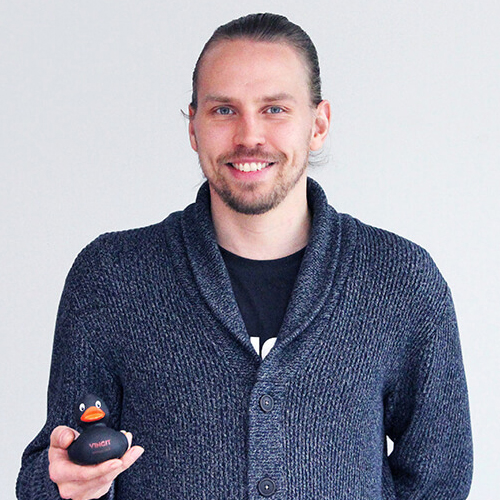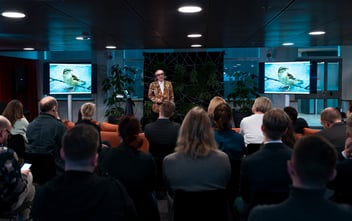In digital design and software, accessibility is a mindset that promotes equal use of services, ensuring that the service is available to all users regardless of what devices they are using or what assistive technologies they may employ. Equal use is made possible by ensuring that content is available with assistive technologies and is accessible to all. While digitalization has made content and services more widely available to more people, content should be designed and implemented with the accessibility perspective in mind.
Based on the skills surveys and analyses we carried out at Vincit, we learned that accessibility is an area in which our experts would very much like to improve. That is why I decided to organize a study group on accessibility at Vincit.
Study groups at Vincit
A study group makes learning social. Vincit’s learning community, Univincity, provides people with services that are meaningful for their career development. Anyone can start a study group at Vincit. First, they need to find colleagues interested in the same topic. The content, such as an online course or license, can be purchased externally so they don’t have to wait for the materials to be produced before starting.
The study groups usually address relatively recent themes. When selecting these topics, we also try to predict those that will be most relevant in the future to maximize the development of knowledge in our organization.
Study group objectives
Our goal was to design our study groups in a way that is pedagogically effective and that encourages collaborative learning. My personal development goal with the study groups was to foster strong collaborative learning within our business environment. And I decided to do it using methods of facilitation.
For each study group meeting, I brought in materials and a list of links. I also documented the model for how to organize a study group so that others can implement it elsewhere. Both the pedagogical model and the study group materials are freely available for any organization, including educational institutions.
Study groups create a network
According to Sydänmaalakka (2001), three factors are key to organizational learning: time, interaction, and trust. Together, these three factors support creativity. Better networking leads to better communication and thus improves the organization’s learning capacity and its capacity for change (Sydänmaalakka, 2001).
When we realized there was a shared interest in developing accessibility skills among both developers and designers, we saw an opportunity to bring together people from different backgrounds to strengthen the study group. When creating new business opportunities, this kind of diversity leads to better results (Nightler & Strong, 2006). For organizational learning, themes that create networks across different roles are valuable (Sydänmaanlakka, 2001), and we wanted to create a network of accessibility experts at Vincit.
Facilitation as a tool for the expert member
For learning to take place in the working environment of an expert organization, several things must be provided: a suitable framework, time for learning, and social support for self-guided opportunities. Most of Vincit’s employees are highly educated and, as such, we can expect them to be internally motivated towards continual self-development. For this reason, my approach was to operate as a facilitator in the study group.
The basic idea of facilitation is to create opportunities for success and the framework for the events. One principle of facilitation is that the facilitator guides a discussion as a moderator, without participating in the production of ideas about the subject matter. Another key principle is the guidance of the group towards a goal defined for the meeting (Grape people, 2011; Mukamas Learning Design, 2020). This position is challenging in some ways because it requires pivoting between roles, and this may also pose challenges to the participants’ focus. Be sure to allow time to communicate about which role you are fulfilling at a given moment. The facilitator must flexibly adopt the roles of content creator, facilitator, and teacher. As such, I heartily recommend it to anyone who wants to become more diverse in their leadership skills.
It is vital to create a psychologically safe atmosphere and framework for participants to achieve the objective of the study group, even if they are responsible for creating the content. These principles are inherent in a facilitation approach. Active participation improves learning outcomes, so it is worth investing in ways to enable active participation.
Company benefits from a study group
1. A study group is a cost-effective and inspiring way to develop employee skills. If the subject of the study group is not completely new, plenty of online materials and courses should be available as a framework. Starting a study group requires only a little time and interest in the topic. Because a study group encourages participation, it is also a more engaging way of learning than externally organized training, and it will provide deeper insight on the theme. The study group’s only costs are the working time it takes and any possible licenses.
2. A study group creates new collective understanding and knowledge on the theme and builds a communal culture of skill development. A properly facilitated study group combines collaborative learning and implementation. Collaborative learning, when properly facilitated, also helps to produce learning material and develops a positive culture of activity within the organization. Active communication about the study group and its success will further support open and transparent discussion regarding learning and development.
3. The material produced by a study group can later be implemented or turned into a product. Organizing a study group and connecting the experts creates a fruitful occasion to develop new knowledge and materials related to the topic or theme. The material archive of a study group along with the ideas produced usually require further processing and revision, but they are a very good starting point for development.
4. A study group creates an internal interest group around an issue. The group brings together interested experts and, when facilitated properly, forms an internal network around the theme. People with an interest and basic knowledge can also be directed to suitable projects (e.g., accessibility audits) to refine their skills.
5. A study group is relatively easy to replicate and duplicate. Once an established study group has been adequately documented, the approach can be easily repeated either for another group within the company or for a customer. In other words, the study group itself can be turned into a product, perhaps as a training package for customers.
Lessons learned from the study group
In the study group, we created materials and procedures for collaborative learning to promote the accessibility skills of participants. Those materials and procedures can be turned into a product, as a training package to be implemented for other companies or educational institutions. The aim of the training package we created is to develop accessibility skills through practical experience in projects. This package uses the theory of accessibility and research results in the operational implementation of adaptive customer projects.
The study group itself creates the basis for obtaining a certificate of accessibility, developing accessibility in an independent project, or developing accessibility expertise. We also formed an accessibility interest group that, for its part, contributes to the development of accessibility skills and projects at Vincit.
Sources:
Grape People (2020), Fasilitoinnin ihme.
Mukamas Learning Design (2020). Oppimisen fasilitointi on jatkuvan oppimisen mahdollistamista.
Möller, K. & Svahn, S. (2006). Role of Knowledge in Value Creation in Business Nets. Journal of Management Studies, 43:5 July 2006, 985-1007.
Sydänmaanlakka, P. (2001). Älykäs organisaatio. Tiedon, osaamisen ja suorituksen johtaminen. 3.painos. Helsinki: Kauppakaari.
At Vincit, accessibility isn’t a checklist — it’s embedded in everything we do. From design to development and testing, we build digital services that everyone can use, because we believe that’s just how things should be. Read more about accessibility at Vincit.



